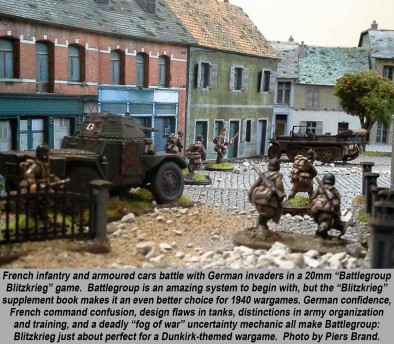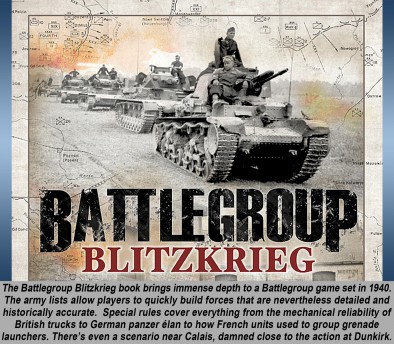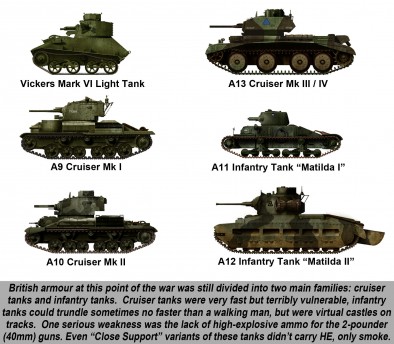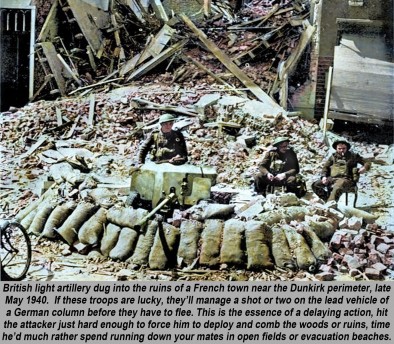The Evacuation Of Dunkirk Part Three: Wargaming At 20mm (Battlegroup)
August 9, 2017 by oriskany
Welcome back, Beasts of War, to our continuing explorations of Dunkirk. With the recent Christopher Nolan movie coming out on the subject, the 1940 Dunkirk evacuations are getting a lot of focus. So it’s only natural to take this opportunity to talk about the wargaming potential offered by this crucial episode of World War II history.
Follow Dunkirk Week Here
So far we’ve reviewed the overall situation at Dunkirk (vital since it explains WHY hundreds of thousands of men had to be so desperately evacuated) and looked at gaming the surrounding battles in 15mm. Now let’s zoom in a little bit for a look at the 20mm battlefield.
Dunkirk In 20mm (Battlegroup)
Here on Beasts of War, 20mm World War II usually means “Battlegroup” by IronFist Publishing. As fans of this system well know, Battlegroup offers a separate campaign book for each of the general theatres covered by the game. For a Dunkirk-themed Battlegroup game or campaign, this is undoubtedly “Battlegroup: Blitzkrieg.”
Now people who know me or have followed my writing over the years know that Battlegroup is probably my favourite single World War II miniatures game. It combines the scale of larger-scale Flames of War battles with the detail and immediacy of smaller-scale games like Bolt Action.
Battlegroup is also a “historian’s wargame,” but this certainly doesn’t mean you have to a “historian” to play it. It “counts the rivets” for you, all the historical homework has already been done. The system is elegant enough to pack plenty of detail in gameplay that still runs very smooth, especially its “Battle Rating Counter” mechanic.
So what makes Battlegroup at 20mm different, and a good fit for the battles and skirmishes that raged around the Dunkirk perimeter during those eight fateful days in May and June, 1940?
Most Battlegroup games are a little smaller than the engagements seen in Flames of War. So we’re talking roughly company-sized (ten tanks, 100 men, or some combination thereof). With a smaller scale, the level of detail is a little higher, demanding that players employ realistic combined-arms tactics to keep their units together under fire.
Battlegroup really puts YOU in the actual commander’s spot, usually allowing you to take in your list only those assets available to lieutenants, captains, or (at the most) a major. Assets like artillery and airpower you usually have to REQUEST, or it just shows up if you’re more than a little lucky … just like in real combat at this scale.
Since we focused on the French in our last article (15mm Flames of War), let’s look at the British for Battlegroup in 20mm. Turns out one of the divisions heavily engaged in holding the Dunkirk Perimeter (giving the rest of the BEF time to escape) was commanded by an obscure, as of yet unheard of major-general: Bernard Law Montgomery.
This was the British 3rd Infantry Division, which is a great division for early war British Battlegroup games. Training and discipline in this division were better than most others at the time, and the division includes a wide array of interesting support units that allows plenty of choices for players building historically-accurate army lists.
These units include a battalion of the famous Coldstream Guards. There’s also an attached battalion of light tanks. Admittedly these are only Mark VI “tankettes,” but beggars can’t be choosers. In the division’s 9th Infantry Brigade there’s also 2nd Battalion / Royal Ulster Rifles, so the BoW team even has a local connection to the Dunkirk battles.
Specifically for Dunkirk actions, the 3rd Infantry Division was heavily involved in the Battle of Wytschaete. This was near the beginning of Operation Dynamo when German forces of 6th Army (Army Group B) were approaching the Ypres Canal from the east. The 6th Army included XVI Corps, built around two panzer divisions (3rd and 4th).
It was here that the British II Corps, including 3rd Division, fought bitter delaying actions along that canal, allowing the rest of BEF more time to get on those ships. There was also a battle at nearby Nieuport, where some of 3rd Division’s guardsmen come up on a British position that had just been routed.
Now accounts differ here. Some sources claim that these guardsmen had to actually shoot a handful of the routing men to restore order, others say they were threatened at bayonet point. I don’t claim to know for sure, but it shows how desperate and frantic some of these delaying actions really were.
The “Delaying Action”
We’ve been throwing around this phrase a lot, so maybe we should talk about what a “Delaying Action” actually is, and how do we use it in a game like Battlegroup. Well, here’s what it’s NOT: a defence. If the defending force on your table has enough strength to possibly hold its own ... you’re probably not doing the “delaying action” right.
Delaying actions are fought when the attacker has an overwhelming superiority in firepower, mobility, support assets, usually all three. This is what makes delaying actions fit in a Dunkirk campaign so well. Remember, Dunkirk isn’t a battle, it’s an evacuation. If the BEF had any chance at all they wouldn’t be leaving France in fishing boats.
In a delaying action, the defender’s job isn’t just only to hold, but also escape. They cannot take too many losses, they’re trying to evacuate, after all. Conversely, the attacker’s job is not only to win but win FAST, to get forces across the table in the minimum amount of time and hopefully cut off the defender’s escape.
To reflect this on a wargame scenario, objectives can be set deep on defender’s side of the table, ideally where roads EXIT the board (reflecting the “breakthrough” aspect of the attacker’s mission). The defender can’t be expected to hold their position, his mission is to cost attacker time and losses, and escape in good order.
Perhaps the defender gets victory points for each turn the game lasts. The longer he prevents a clean breakthrough, the better he does. Specifically, in Battlegroup, we’ve experimented with forcing the attacker to draw battle rating counters (how you lose the game) after each turn. The longer the game, the more chance the attacker loses.
How would you handle the “delaying action” on your gaming table? How would you reflect the defender’s challenge of buying time for others to get on those ships, but also escape and get on those ships themselves? Drop your ideas, questions and comments below, and keep the conversation going around this incredible moment in World War II history.
If you would like to write an article for Beasts of War then please contact us at [email protected] for more information!
Supported by (Turn Off)
Supported by (Turn Off)
Supported by (Turn Off)





























![How To Paint Moonstone’s Nanny | Goblin King Games [7 Days Early Access]](https://images.beastsofwar.com/2024/12/3CU-Gobin-King-Games-Moonstone-Shades-Nanny-coverimage-225-127.jpg)

















































Working in Ieper, let me give you a hand on pronunciation 😀
Pronounce this in regular English and you should approximate it:
Ee-per (Ieper)
Wade-shah-the (Wijtschate)
Anyway, interesting article and a great series! ^^
Oh God, thank you, @neves1789 . Like I supplicate in the interview: “I apologize to all the cultures of Western Europe for what I just did!” 😮
A little late for appologies, we are very offended! :p
Oh and Lille (called Rijsel (Ray-sel) in Dutch, since it’s an old French-Flemish town) is pronounced Leel, like Lee with an L at the end!
@neves1789 Always enjoy going to Ieper. Thought of moving there once but never came about sadly
I’ve just realised that I’m not losing my games but actually playing a “delaying action” 🙂
Seriously though I do like the idea of this as a way of changing up a game.
Epic perspective, @jamjarst ! That’s the spirit! 😀 😀 😀
I have done more than a few delaying action games in my time. One mechanic, which has worked really well is having the defender roll a pair of D6 every turn secretly, and keeping the results as a running total, once a given target is reached, say 40 or 50 for sake of argument, the defending side can then withdraw. The attackers get points for each unit they exit off the table during the game (thus reflecting the attacker’s most likely mission, which is continuing the pursuit).
I just realized, in Battlegroup, you could probably change that to BR counters in some form or fashion…
Yes, @panzerfaust150 – we just draw one (or two in a larger game) BRCs at the end of each turn to add an additional time pressure to the attacker. If the “defender” plays for enough time and the attacker winds up hitting his BR cap, the attacker force gets a call from HQ: “Break off, you’ve failed, we’ve achieved a bigger breakthrough somewhere else” or “Break off, the larger enemy parent force has already escaped.”
Again, the attacker needs to have a huge advantage in firepower, mobility, support assets, etc, to balance this game out.
That’s actually not a bad idea. I like the 2d6 or even 3d6 mechanic, bell curves in multi-dice results keep the results from getting too random.
Huge fan of Twilight 2000 back in the day. I remember trying to get my tank column to Krakow in the original versions of the game. 😀 I still have some of those books in .pdf form somewhere . . .
I am beginning to worry about Gerry wearing the same t shirt 3 days running or is it *shock horror* all been filmed in the same day?
No I’m like Einstein. I have 7 sets of the same clothes so I never have to worry about what I’m wearing
We laugh, but back in the military (where you wear the same camouflage-pattern BDUs every work day) there’s at least one “laundry-averse” guy in every platoon that refuses to change clothes, but it’s really hard to tell until you can smell him coming. 😀
Been there, smelt that, they are knicknamed “mingers” in the British Army; a bell ringing, sh1t flinging, humdinging, king minger!!
We’re not nearly that advanced over here, @brucelea – “Shitbirds” was the blanket term I remember from the USMC. Is minger short for “malingerer?” That kind of thing?
Yes Jim, it’s a bit bastardised between that (being so lazy as to not bother washing) and the slang word minger which means that something stinks. That is further twisted as it can also refer to the looks of a person. Gotta love the English language!!
@brucelea – English? Maaan, I don’t talks no English! I’m ‘Merican! I talks ‘Merican reel good!
Several of the scenarios in Battlegroup Wacht am Rhein use exactly the mechanic that @oriskany describes to add a time limit to the German forces.
At the end of each turn, after the fourth, the German player has to take a chit.
This allows a very out-gunned force to still achieve victory against a powerful enemy. It also forces the German player to act in a correctly aggressive manner as at the period.
Great article guys, like it!
Awesome, thanks very much @piers !
We briefly mention the Battlegroup Blitzkrieg scenario at Calais-St.Omer road as a “pre-Dunkirk” example of Battlegroup during this period (I think the scenario takes place on May 23, so a few days before Dunkirk evacuations actually begin). Any others that come to mind?
Well the two Cassel scenarios in this month’s Wargames Illustrated are perfect ones for Dunkirk rearguard.
Will have a look what else we have… you could probably run a nice little narrative themed campaign juat using the generic scenarios from the new rulebook.
I hope to run at least one Dunkirk-themed BG game this weekend, perhaps something near the Ypres Canal, so we can start putting material in our usual supporting thread that gets set up in the forums. 😀 I have all my early war BEF-esque armor originally built for SeaLion and North Africa.
@warzan I have heard from some Facebook forums that Rich Clarke is now over there with you all. Hope your having fun
Just saw the 40K segment in Backstage. So t here’s clearly content rolling out besides my articles and or interviews. 😀 😀
It’s one thing with some systems that everything is geared around a balanced game (thankfully not the case now with 40K 3 ways to play). I for one relish playing an historical game with real life org charts so that I can put my wits against the odds to see If I can change the course of history. Surely that’s the very essence of why we play war games, to pit yourself against a worthy opponent, against the odds, and against how much time you have before the obergruppenfurher says it’s time to clear the dining table! Will have to… Read more »
Awesome comment, @brucelea – this is the methodology my group and I have tried to use when running, say Panzer Leader games in campaigns that are decidedly “unbalanced” (Barbarossa 1941, Blitzkrieg 1940, Liberation of the Ukraine 1944, etc). We mass as much historical information as we can, convert that into PanzerBlitz / Leader, and then set the HISTORICAL OUTCOME as the “draw line.” (If this happens, the game is a draw, etc). If one player or the other manages to do just a little better than their historical counterpart, he is considered the winner. The only issue with this approach… Read more »
I must say, I am really enjoying the almost side by side comparison of the different scales/gaming systems and how they can be used in the same setting. Many times I’ve read things where if you want to play this scenario you must go buy a new army in a new scale, or sorry you like 28mm so there is no way to play as part of a major battle/campaign. Very cool.
You’ll set my bugbear rant off with that sort of statement 🙂
That’s the big bonus on historical gaming, you can use models from wherever. No one owns the “image” of a PzKpfw III. Some companies are better but more expensive, or have too many parts, or don’t produce in plastic, or are never available, etc. It’s not like other genres, where only one company is “allowed” to make X-Wings or Space Marines, etc. Also, I always like smaller scales (bigger battles). When I play Battlegroup I usually do it in 15mm. Some people like 10 or even 6mm, but for me personally, once you get that small it’s time for hexes… Read more »
would be interesting to enact a holding action for a set number of turns to slow the advance.
Man, I keep promising this, but please no one hold me to it 100% . . . I’m gonna try for a Battlegroup delaying action game this weekend.
Always wanted to try battlegroup, but didn’t got around to it yet. @oriskany you say you can play it in 15mm, which would be perfect, as we all have a lot FoW minis around here. But do you need individual based infantry man? As you might know for FoW you normally have 4-5 guys on one base. Can battlegroup be played with infantry based like this?
Just use one base to represent a figure. As long as everything is based the same I’m sure it’s not going to make much if any difference
Thanks for the advice @torros and @oriskany . I will definately try this out.
Cool deal,@bothi – The one rule in Battlegroup I sometimes ditch is ammo tracking for tanks. It can make for some great decisions at the beginning (this Pz III can carry 8 “rounds” – do I carry four HE and four AP? All AP? Maybe six AP and two HE? What kind of targets am I most likely to face?) It can lead to moments where you really want to save your AP ammunition, and use HE ammo for really close or easy kills. That Pz III right next to a Bren carrier . . . might want to try… Read more »
Thanks again Jim. Good adivce there. I am already trying to gather up some folks around here who will try it with me. The “you can use your already existing models” makes a great argument.
Oh, hell yeah, @bothi – that’s what sold it to me as well. That, and the historical aspect. 😀
Good advice @oriskany. Don’t forget that FoW played at this part of the war should be done using the V4 early and late war rules or the V3 rules. Either one has much greater detail than the V4 Mid War rules. If you have a choice the V4 early and late war rules gives you a faster game. As I play both Battlegroup and FoW here is my advice. If you are only interested in if a village is taken or not then go with FoW as it will play out faster. If your interested in how the village fell… Read more »
Great advice, @jamesevans140 – Indeed that was the general guideline for these articles and interviews. What kind of different aspects of a battle do the different systems and scales do best? All these games so SOMETHING better than the others. What makes a player choose a “favorite” game I think is just that their game applies to some aspect of wargaming they enjoy more than others.
Too true @oriskany.
Amazingly I have encountered a number of players that not only pick the wrong game for them, but also the wrong type of army. I know a number of players that use FoW for raids and special forces actions. Really Battlegroup or Built Action are better suited for this kind of action. More than half of these players are too cautious, not a good special forces attribute.
Agree 100% @jamesevans140 – Say, for SeaLion . . . I used Panzer Leader 1940 for the bigger command-tactical battles, Battlegroup for the tactical battles, and Force-on-Force for the 20mm commando raid on Dover. 😀
Having had a super-busy few months I’ve not managed to properly go through a lot of the (relatively) text-heavy article series in a while, so I’m really enjoying catching up on Dunkirk week. One thing I would like to ‘correct’ though @oriskany is about ‘normal’ / popular wargames being balanced – this whole ‘in real life generals don’t meet the night before to agree on a points value’ thing. The whole point of using points values in games is to provide a balanced scenario between unbalanced forces. An _unbalanced_ game would be 50 space marines ambush 50 orks and wipe… Read more »
I think we may be talking about two different things. 100 orcs at 5 points a piece and 10 marines at 50 points a piece is still a “point-balanced” game at 500 per side. We’re talking about say 500 points vs. 1000, 2000, or 3000 points. With the leverage of the balance undertaken completely out of the mechanic of “points.” i.e., 500 vs, 1200 points, but the 500 point game only has to defend a fortified position, or only has to last turns, or has to successfully defend an evacuation, or the 1200 point force has to come on the… Read more »
Points and balanced games are a personal preference thing of the groups of players that are out there and what they wish to get out of it. In fact it would be preferable for a group just starting out to use points while learning the rules and their armies. Once they are comfortable with both they are in a much better position to design unbalanced scenarios that the group will enjoy playing. The hardest thing for the individuals of the group to learn is that it can be fun losing a game under the right conditions. My biggest issue is… Read more »
I agree. But I would always add setting and context to a game, even if it had no rules impact. It’s pretty easy to agree with your opponent where you’re fighting, who you’re fighting, why you’re righting, etc. This can guide terrain set up to ensure that you’re playing on a themed board.
And even if you do nothing else; you don’t touch the ‘balanced’ victory conditions of your ‘out of the book’ tournament scenario, you can still have a much, much more interesting game.
I agree with @jamesevans140 on this one. Been wargaming systems like PaznerBlitz, Panzer Leader, Arab-Israeli Wars, GDW Assault Series, etc . . . and frankly never heard of “points” until 2010. I think it was Axis & Allies 15mm miniatures that first introduced me to the concept.
A convenient starting point, at least until you get used to the system sufficiently to where you can start “shotgun” crafting scenarios on your own.
Too true @angelicdespot and @oriskany. The otherwise of the coin is not to get over dependent on points balance as it will deprive you of your best games. Context is usually the first to go followed by a growing dependence on points balance. This leads to armies design by the points that have no historic context. The makeup of the force quickly becomes non historic. This leads to the tragic loss of the history. Oddly most players I have met that play only points balanced games don’t seem to have a good grasp of combined arms to get the very… Read more »
Thanks, @jamesevans140 – @aras and I have finally been able to run our own Dunkirk-themed delaying action in Battlegroup this weekend. http://www.beastsofwar.com/groups/historical-games/forum/topic/dunkirk-themed-delaying-action-brit-vs-german-battlegroup/ No points (actually didn’t have time for points, besides) but did try to take a stab at battle rating for each force (roughly, two points per squad or tank, then take some off to tighten up the game’s tension). The German force obviously was MUCH larger with a MUCH higher battle rating, but had to draw a BRC at the end of every turn. I (as the British player) also had access to some artillery, two bridges to… Read more »